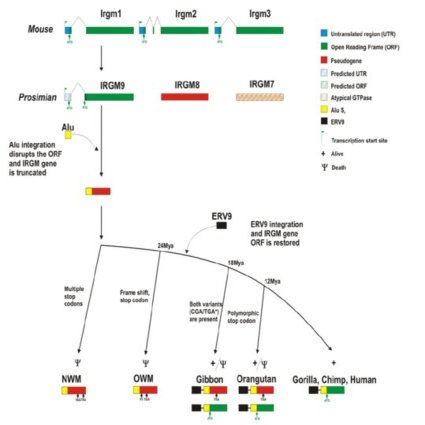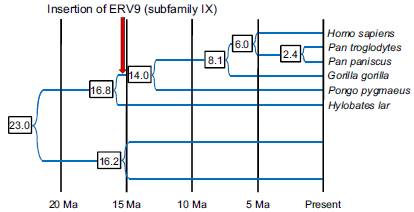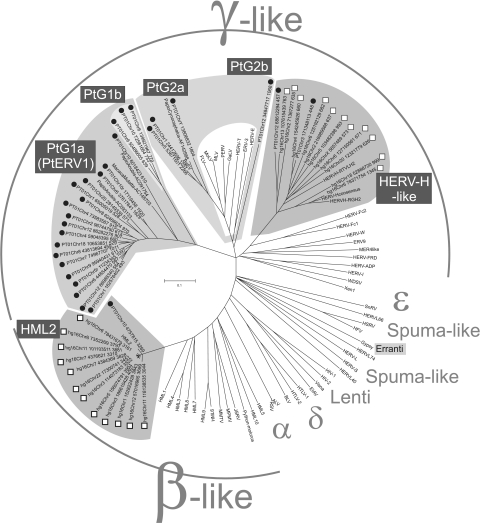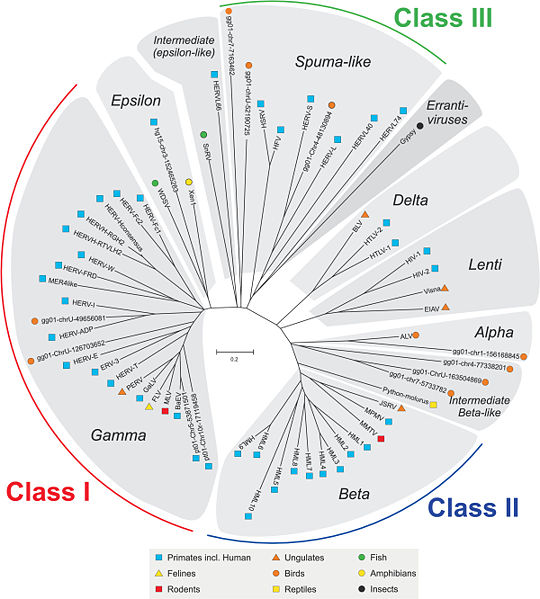
Mammals : Primate Evolution via Infectious-Symbiotic Speciation Events
Hypothesis: Retroviral Infections are the mechanisms of macrogenetic change during Mammalian, Primate, and Hominoid Evolution
Prediction: The next human evolutionary event will be a symbiosis of the HIV virus into the germ line and the creation of a new subspecies of Homo.
Evidence:
Human Endogenous Retrovirus M infections occured 55 million years ago in a Primate Ancestor. Other retroviruses endogenized about 30 to 35 ma after the divergence of old and new world monkeys.HERV K family infections occured 39 million years ago ,28 million years ago and 14 to 19 million years ago during the hominid radiation. An African great ape lineage infection occured 3 to 5 mya. The modern Human lineage diverged from a branch leading to Neanderthals and Denisovans 800 K years ago and shows a different pattern of certain types of HERV K integrations. There is also evidence of an ancient East African Lineage of Humans from 400 K years ago that gave rise to the Modern Human Group of South Africa. The South African Early Modern Group Migrated to North East Africa and subsequently into Arabia and the rest of the world. It is postulated that the early East African Human Lineage has a different pattern of HERV-K integrations compared to the Early Modern Lineage of South Africans. There is also evidence of a mitochondrial gene transfer event to the Nuclear DNA in Modern Humans about 40K years ago. However, this may or may not be related to retrotansposon activity due to endogenous retroviruses.
The date of the human chromosomal fusion event not yet been determined but is estimated to have occurred about 1 Million years ago. (ie. predating the branching off of Neanderthals and Denisovans).
A question that remains to be answered is : What was the zoonotic or close species source of the exogenous HERV-K Viruses that became endogenous ? or Did something activate endogenous HERV K elements to proliferate in the germ lines of different lineages?
Evidence of common ancestry ERVs (video)
XA34 ERV-9 like integration into the germ line 40-45 million years ago

6.
7. The Solitary Long
Terminal Repeats of ERV-9 Endogenous Retrovirus Are Conserved during Primate
Evolution
and Possess Enhancer Activities in Embryonic and
Hematopoietic Cell (15-18 million ya)
8. Endogenous retrovirus drives hitherto unknown proapoptotic p63 isoforms in the male germ line of humans and great apes 15 million years ago


10. HERV W LTR family proliferation during the past 2-5 million years
11. Divergent patterns
of recent retroviral integrations in the human and chimpanzee genomes: probable
transmissions between other primates and chimpanzees.
Jern P, Sperber GO, Blomberg J.
Classes of Retroviruses

Taxonomy of ERV 9 and other retroviruses
Identification, phylogeny, and evolution of retroviral elements based on their envelope genes.
Lavie, L., P. Medstrand, W. Schempp, E. Meese, and J. Mayer. 2004. Human endogenous retrovirus family HERV-K(HML-5): status, evolution, and reconstruction of an ancient betaretrovirus in the human genome. J. Virol. 78:8788–8798.
Sverdlov, E. D. 2000. Retroviruses and primate evolution. Bioessays 22:161–171
Medstrand, P., and D. L. Mager. 1998. Human-specific integrations of the HERV-K endogenous retrovirus family. J. Virol. 72:9782–9787.
Yohn, C. T., Z. Jiang, S. D. McGrath, K. E. Hayden, P. Khaitovich, M. E. Johnson, M. Y. Eichler, J. D. McPherson, S. Zhao, S. Pa¨a¨bo, and E. E. Eichler. 2005. Lineage-specifc expansions of retroviral insertions within the genomes of African great apes but not humans and orangutans. PLoS Biol. 3:e110.